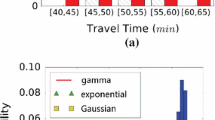Abstract
A driver’s choice of a route to a destination may depend on the route’s length and travel time, but a multitude of other, possibly hard-to-formalize aspects, may also factor into the driver’s decision. There is evidence that a driver’s choice of route is context dependent, e.g., varies across time, and that route choice also varies from driver to driver. In contrast, conventional routing services support little in the way of context dependence, and they deliver the same routes to all drivers. We study how to identify context-aware driving preferences for individual drivers from historical trajectories, and thus how to provide foundations for personalized navigation, but also professional driver education and traffic planning. We provide techniques that are able to capture time-dependent and uncertain properties of dynamic travel costs, such as travel time and fuel consumption, from trajectories, and we provide techniques capable of capturing the driving behaviors of different drivers in terms of multiple dynamic travel costs. Further, we propose techniques that are able to identify a driver’s contexts and then to identify driving preferences for each context using historical trajectories from the driver. Empirical studies with a large trajectory data set offer insight into the design properties of the proposed techniques and suggest that they are effective.

















Similar content being viewed by others
Notes
A recent study [27] from Microsoft Research Asia suggests that although some services (e.g., Google Maps, Bing Maps, and Yahoo! Maps) can display time-dependent traffic conditions, such information is not used in their routing services.
FlexDanmark is a large fleet manager in Denmark. See https://www.flexdanmark.dk/.
Given a vector \({\mathbf {c}}\), the \(i\)th element of the vector is denoted as \({\mathbf {c}}[i]\).
We use “personalized skyline route” instead of “skyline route” because when deriving the cost vector for a route, we consider driver \(d_m\)’s driving behavior which is quantified by \(d_m\)’s personal ratio.
Here, the weights refer to the lengths of edges. Alternative weights may refer to the travel times or the fuel consumption of edges. We do not consider them in the experiments because both travel time and fuel consumption of edges are uncertain, rendering them unattractive for use as weights.
References
Balteanu, A., Jossé, G., Schubert, M.: Mining driving preferences in multi-cost networks. In: SSTD, pp. 74–91 (2013)
Bishop, C.: Pattern Recognition and Machine Learning. Springer, Berlin (2006)
Ceikute, V., Jensen, C.S.: Routing service quality—local driver behavior versus routing services. MDM 1, 97–106 (2013)
Chen, B.Y., Lam, W.H.K., Li, Q., Sumalee, A., Yan, K.: Shortest path finding problem in stochastic time-dependent road networks with stochastic first-in-first-out property. IEEE Trans. Intell. Transp. Syst. 14(4), 1907–1917 (2013)
Chen, Z., Shen, H.T., Zhou, X.: Discovering popular routes from trajectories. In: ICDE, pp. 900–911 (2011)
Dai, J., Yang, B., Guo, C., Ding, Z.: Personalized route recommendation using big trajectory data. In: ICDE, pp. 1–12 (2015)
Dong, W., Li, M., Vo, Q.B., Vu, H.L.: Reliability in stochastic time-dependent traffic networks with correlated link travel times. In: Intelligent Transportation Systems (ITSC), 2012 15th International IEEE Conference on, pp. 1626–1631. IEEE (2012)
Fürnkranz, J., Hüllermeier, E.: Preference learning: an introduction. In: Preference Learning, pp. 1–17. Springer, Berlin (2011)
Google maps and speed limits. http://tinyurl.com/n5gtjc4
Guo, C., Ma, Y., Yang, B., Jensen, C.S., Kaul, M.: Ecomark: evaluating models of vehicular environmental impact. In: SIGSPATIAL/GIS, pp. 269–278 (2012)
Guo, C., Yang, B., Andersen, O., Jensen, C.S., Torp, K.: Ecomark 2.0: empowering eco-routing with vehicular environmental models and actual vehicle fuel consumption data. GeoInformatica 1–33 (2014). doi:10.1007/s10707-014-0221-7
Kriegel, H.-P., Renz, M., Schubert, M.: Route skyline queries: a multi-preference path planning approach. In: ICDE, pp. 261–272 (2010)
Letchner, J., Krumm, J., Horvitz, E.: Trip router with individualized preferences (trip): incorporating personalization into route planning. In: AAAI, pp. 1795–1800 (2006)
Luo, W., Tan, H., Chen, L., Ni, L.M.: Finding time period-based most frequent path in big trajectory data. In: SIGMOD Conference, pp. 713–724 (2013)
Miller-Hooks, E.D., Mahmassani, H.S.: Least possible time paths in stochastic, time-varying networks. Comput. Oper. Res. 25(12), 1107–1125 (1998)
Neyman, J., Pearson, E.S.: On the Problem of the Most Efficient Tests of Statistical Hypotheses. Springer, Berlin (1992)
Nie, Y.M., Wu, X.: Reliable a priori shortest path problem with limited spatial and temporal dependencies. In: Transportation and Traffic Theory 2009: olden Jubilee, pp. 169–195. Springer, Berlin (2009)
Nie, Y.M., Wu, X.: Shortest path problem considering on-time arrival probability. Transp. Res. Part B Methodol. 43(6), 597–613 (2009)
Pereira, F., Costa, H., Pereira, N.: An off-line map-matching algorithm for incomplete map databases. Eur. Transp. Res. Rev. 1(3), 107–124 (2009)
Rogers, S., Fiechter, C.-N., Langley, P.: An adaptive interactive agent for route advice. In: Agents, pp. 198–205 (1999)
Seshadri, R., Srinivasan, K.K.: Algorithm for determining most reliable travel time path on network with normally distributed and correlated link travel times. Transp. Res. Rec. J Transp. Res. Board 2196(1), 83–92 (2010)
Spearman, C.: ‘Footrule’ for measuring correlation. Br. J. Psychol. 2(1), 89–108 (1906)
Vapnik, V.: The Nature of Statistical Learning Theory. Springer, Berlin (2000)
Wellman, M.P., Ford, M., Larson, K.: Path planning under time-dependent uncertainty. In: UAI, pp. 532–539 (1995)
Yang, B., Guo, C., Jensen, C.S.: Travel cost inference from sparse, spatio-temporally correlated time series using Markov models. PVLDB 6(9), 769–780 (2013)
Yang, B., Guo, C., Jensen, C.S., Kaul, M., Shang, S.: Stochastic skyline route planning under time-varying uncertainty. In: 30th international conference on data engineering. ICDE, Chicago, pp. 136–147 (2014)
Yuan, J., Zheng, Y., Xie, X., Sun, G.: T-drive: Enhancing driving directions with taxi drivers’ intelligence. IEEE Trans. Knowl. Data Eng. 25(1), 220–232 (2013)
Acknowledgments
This work was supported by the REDUCTION project, funded as EU FP7 STREP Project No. 288254.
Author information
Authors and Affiliations
Corresponding author
Rights and permissions
About this article
Cite this article
Yang, B., Guo, C., Ma, Y. et al. Toward personalized, context-aware routing. The VLDB Journal 24, 297–318 (2015). https://doi.org/10.1007/s00778-015-0378-1
Received:
Revised:
Accepted:
Published:
Issue Date:
DOI: https://doi.org/10.1007/s00778-015-0378-1




